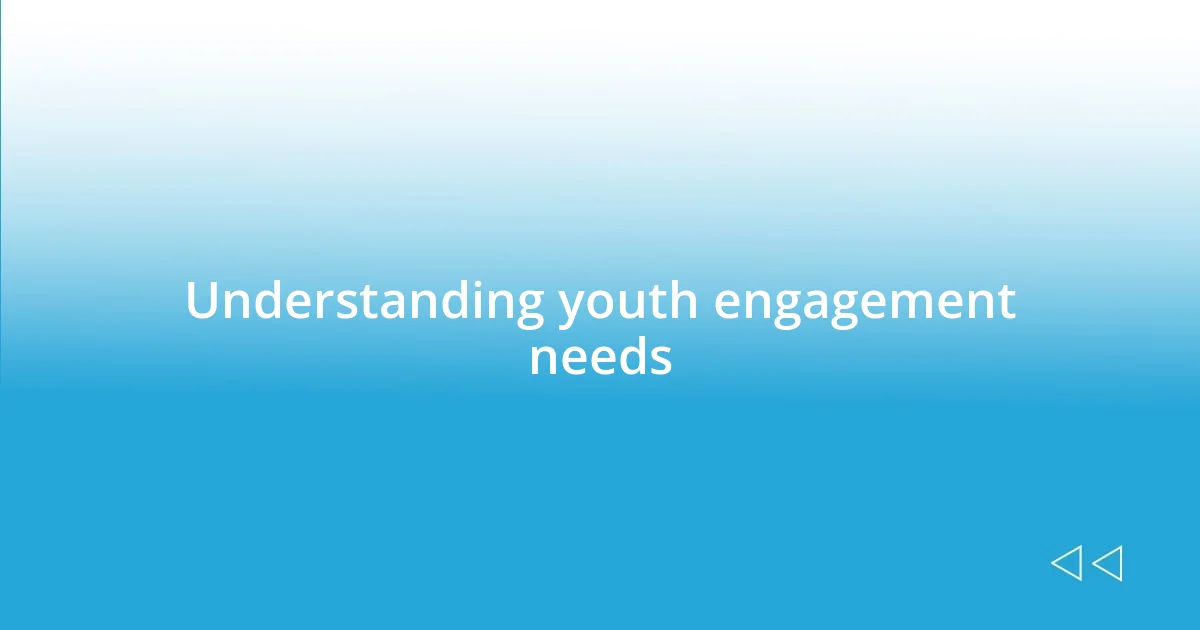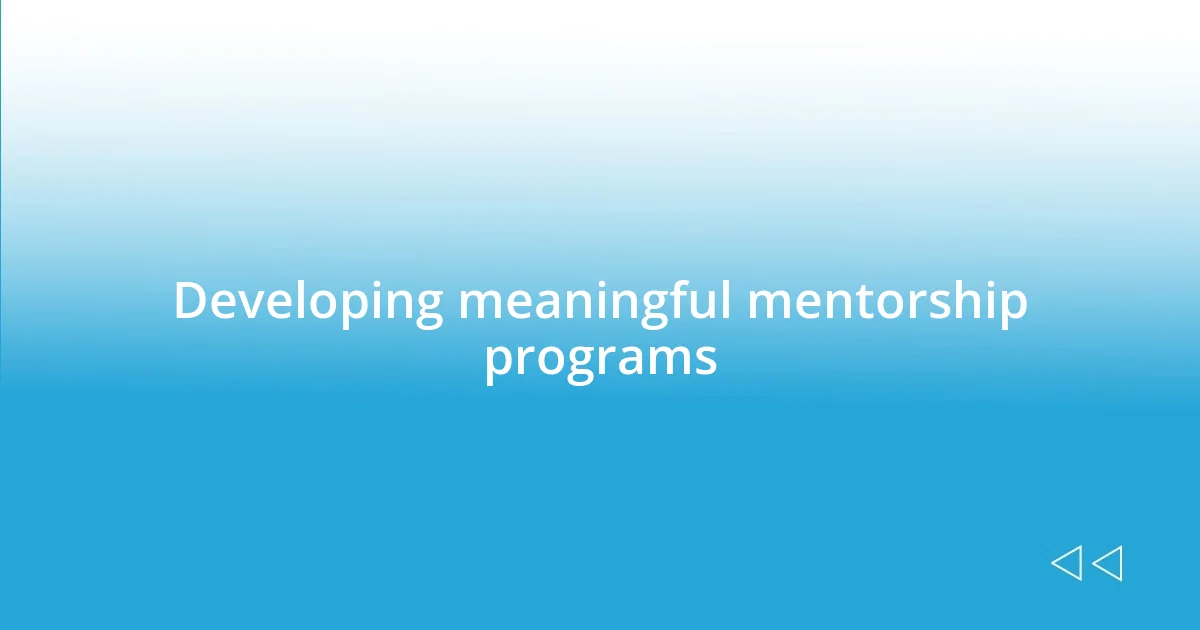Key takeaways:
- Authenticity, belonging, and autonomy are critical for effective youth engagement, fostering environments where young people feel valued and motivated to participate.
- Building trust through personal connection, consistent communication, and genuine presence enhances relationships and encourages open dialogue with youth.
- Incorporating technology and creative strategies, like interactive workshops and peer-led sessions, energizes youth participation and creates a more engaging atmosphere.

Understanding youth engagement needs
To truly understand youth engagement needs, we have to recognize their desire for authenticity and relevance. I remember leading a workshop where the youth shared they felt unheard when discussions didn’t connect to their daily lives. It’s as if they were speaking a different language; I realized the importance of incorporating their interests and passions into our activities to build that crucial bridge.
Engagement also hinges on the sense of belonging. I once volunteered at a community center where a young girl expressed her anxiety about fitting in. It struck me that when youths feel valued and included, they open up—it’s all about creating a space where they can express themselves freely. How do we cultivate that environment? We listen, we adapt, and we encourage them to take the lead whenever possible.
Lastly, I’ve noted that autonomy plays a significant role in engagement. When I first started working with teens, I often dictated activities, but I soon learned that letting them take charge created an electric energy in the room. It makes me wonder: what if we approached youth engagement not just as facilitators, but as partners? This shift in perspective can transform passive participation into vibrant involvement.

Building trust with young people
Building trust with young people is essential for meaningful engagement. I often find that sharing my own experiences creates a sense of connection. For instance, during a mentoring session, I opened up about a challenge I faced in my teenage years. This vulnerability encouraged the young people to share their stories, transforming our interaction from a one-way street into a dialogue based on trust.
Establishing consistent communication is another critical element. I once worked on a project where we set up weekly check-ins with youth participants. It was incredible to witness how each meeting solidified our relationship; each session built on the last, reinforcing their confidence in me. They began to share not only their thoughts on the project but also their hopes and frustrations, revealing the depth of trust that had developed.
Finally, the power of being present cannot be overstated. I recall a time when I volunteered to help at a local event. Instead of just overseeing activities, I took time to genuinely connect with the young attendees. I listened without distractions, and I could see how their faces lit up when they felt heard. It was a fantastic reminder that sometimes, just being there is enough to build that essential trust.
| Element of Trust | Example |
|---|---|
| Authenticity | Sharing my personal teenage struggles |
| Consistency | Regular check-ins with youth participants |
| Presence | Engaging genuinely at a local event |

Encouraging active participation strategies
Encouraging active participation among youth requires creative strategies that resonate with their energy and enthusiasm. During a community project, I noticed that when we gave the youth a platform to brainstorm their ideas, the room transformed. There was this palpable excitement as they freely shared visions that reflected their passions. When they feel ownership over the activities, I find they’re much more likely to engage wholeheartedly.
Here are some strategies I’ve found effective:
– Interactive Workshops: Hands-on experiences allow for exploration and creativity.
– Peer-Led Groups: Allowing youth to lead sessions fosters confidence and leadership.
– Feedback Loops: Regular check-ins where they can voice opinions helps in crafting a responsive environment.
– Goal-Setting Sessions: Setting personal or group goals gives them a sense of direction and accountability.
Another key aspect to active participation is incorporating technology in engaging ways. I recall an instance when we introduced a digital platform where participants could express their thoughts anonymously. The engagement skyrocketed when they realized they could share without fear of judgment. This approach showed me that integrating familiar tools can bridge the gap between their world and our activities, creating a more inviting atmosphere.
- Social Media Updates: Using platforms they’re comfortable with to share progress and updates.
- Gamification Elements: Turning tasks into games can be incredibly motivating.
- Virtual Meetups: For wider reach, online gatherings can include youth who might not be able to participate in person.
- Interactive Polls: This allows them to actively voice their preferences during planning stages.

Creating inclusive environments
Creating inclusive environments is all about making everyone feel valued and heard. I remember a workshop I facilitated where I intentionally mixed small groups with diverse backgrounds. One young participant, who usually kept to themselves, surprised us all by sharing an insightful perspective that resonated with many. That moment reminded me of the magic that happens when we create spaces where everyone feels safe to express their thoughts, no matter how different they might seem.
In my experience, physical space matters too. I once transformed a dull meeting room into a vibrant, inviting setting with comfortable seating arrangements and colorful art made by the youth themselves. This simple change sparked conversations that might not have happened in a more traditional setup. It made me wonder: how often do we underestimate the impact of our surroundings on engagement? Sometimes, the right environment can enhance connections and foster inclusivity, which is something I strive for in all my youth engagements.
Finally, inclusivity extends beyond just physical spaces; it also involves the language we use. I’ve seen firsthand how powerful it is to adopt a conversational tone that welcomes diverse voices. In one instance, I made a conscious effort to use straightforward language during discussions instead of technical jargon. This shift encouraged quieter participants to share their thoughts, and I could sense their relief when they realized they didn’t need to “speak a certain way” to be understood. Creating an atmosphere where language is accessible can help unlock the potential of every young person in the room.

Utilizing technology for engagement
When it comes to utilizing technology for engagement, I’ve found that the tools we choose can profoundly impact participation levels. For instance, during one project, we used a collaborative app that allowed youth to contribute ideas in real-time during brainstorming sessions. The buzz in the room was electric; as they saw their thoughts materialize on screen, their enthusiasm soared. It was a simple yet effective way to harness their love for technology and make the process feel relevant to them.
One memorable experience was when we integrated a game-based learning platform into our workshops. The youth were initially skeptical, but once we kicked off a friendly competition, their competitive spirits ignited. They became fully invested, discussing strategy and collaborating with each other in ways I hadn’t anticipated. I remember one young person saying, “This feels like actual fun, not just another workshop!” It made me think: how often do we miss the opportunity to connect when we don’t tap into their interests?
I also discovered that messaging apps can serve as powerful tools for engagement. During a mentoring program, I set up a group chat where participants could share quick updates and seek advice. The informal setting created a sense of community that spilled over into our in-person meetings. One evening, a member shared a personal challenge, prompting an outpouring of support from peers. In that moment, I realized how technology could facilitate deeper connections; it made me ask myself, “What if we’re only scratching the surface of what’s possible with tech in youth engagement?”

Developing meaningful mentorship programs
Developing meaningful mentorship programs hinges on creating authentic connections between mentors and mentees. I recall a time when I matched a seasoned mentor with a young participant who was struggling with self-confidence. Their weekly chats not only helped the mentee gain clarity about their goals but also encouraged the mentor to reflect on their own journey. This mutual growth was a reminder of how mentorship goes both ways; it truly is about fostering a two-way street of understanding and development.
I also learned that building these programs requires flexibility and adaptability. In one instance, I organized a series of mentorship meet-ups, only to realize that some participants preferred one-on-one coffee chats rather than formal gatherings. So, I embraced this insight and adjusted the format to include more casual settings. The result was astounding: I witnessed mentees opening up in ways they wouldn’t have in a structured environment. It made me ponder—what small adjustments can make a tremendous difference in engagement?
Moreover, establishing common goals can significantly enhance the mentorship experience. I often encourage mentors to facilitate discussions about expectations and aspirations right from the start. During one session, a mentor and mentee mapped out their vision together, which sparked a powerful sense of purpose. The energy in the room shifted as they realized they were on a shared journey. I can’t help but think how crucial it is to align intentions early; after all, when both parties feel invested, the relationship transforms into something truly impactful.

Evaluating engagement effectiveness
To truly evaluate engagement effectiveness, I’ve learned that feedback loops are essential. After a workshop, I once asked participants to rate their experience using a simple post-it note system—green for positive, yellow for neutral, and red for negative. It was eye-opening! The visual representation of their feelings created a tangible insight into what worked and what didn’t. It made me wonder: are we often overlooking such simple methods to gauge genuine engagement?
Another method that struck me as effective was conducting reflective discussions post-activity. During one session, I facilitated a roundtable where youth shared their thoughts about our group project. The conversation flowed effortlessly, revealing deeper levels of understanding and connection than I anticipated. One participant even mentioned how they never felt heard in other settings. It’s moments like these that illuminate the importance of providing safe spaces for open dialogue. They really make me think about how we can enhance engagement through communication.
Finally, I now realize the importance of adapting our approaches based on collective observations. There was a time when we noticed a drop in engagement during our regular meetings. Instead of ignoring it, we collectively decided to reformat our sessions, introducing smaller group activities focused on peer-learning. The shift was palpable; energy levels rose and participation thrived. It taught me that the willingness to adapt isn’t just about responding—it’s about actively listening to the needs of our youth. Isn’t it fascinating how small tweaks can lead to profound transformations in engagement?













